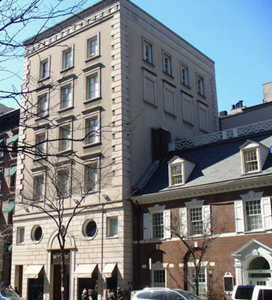Report Assesses Value of Landmark Preservation 50 Years After Passage of New York City Landmarks Law
Rebuts Claims From Real Estate Board of New York as Self-Serving

720 Madison Avenue (left)
New construction that replaced a vacant lot,
Upper East Side Historic District.
Beyer Blinder Belle Architects & Planners LLP, 1996
Gregory Dietrich, photographer, 3/9/14
A Proven Success – CECPP Report
Opening Letter from HDC President Leo Blackman
A new report shows how landmark designation by the New York City Landmarks Preservation Commission positively affects such vital civic concerns as community stabilization, affordable housing, sustainability, job creation and tourism. The study, prepared by the Citizens Emergency Committee to Preserve Preservation and released by the Historic Districts Council, details how the 1965 New York City Landmarks Law establishing the NYC Landmarks Preservation Commission has helped improve the city over nearly fifty years. Entitled “A Proven Success: How the New York City Landmarks Law and Process Benefit the City” (hdc.org/ A-Proven-Success-CECPP-Report.pdf) responds to an anti-landmarking campaign mounted by the Real Estate Board of New York.
“The success of New York City’s Landmarks Law and the Landmarks Preservation Commission has been validated by the extensive benefits accruing to New York City, its residents and visitors,” said Leo Blackman, president of the Historic Districts Council, the citywide advocate for New York’s historic neighborhoods. “Preservation has stimulated a series of neighborhood revitalizations that have boosted multiple sectors of the economy, while also ensuring that the city is a better place to live and work. Beyond economics, New York City’s preservation law and agency have yielded social benefits ranging from preserving neighborhoods to promoting sustainability,” said Blackman.
The study analyzes the Landmarks Law and its economic, social, and environmental impact on the city. It specifically responds to allegations by the Real Estate Board of New York about the regulation of historic properties in New York City. “REBNY has opposed the Landmarks Law since Mayor Wagner signed the legislation in 1965, and they have been wrong about it ever since. They were wrong about designating the Broadway theatres, wrong about Ladies Mile, and now they are wrong about the supposed evils of preservation. This report sets the record straight,” said Dr. Jeffrey Kroessler, Chair of the Citizens Emergency Committee.
Seeking to exploit the de Blasio’s administration’s emphasis on affordable housing, REBNY has most recently blamed historic district designations for the lack of it. The report counters that “because the Landmarks Preservation Commission does not regulate use, historic district designation does not prevent the development of new and/or affordable housing or impede the redevelopment of a designated property into affordable housing units….[Moreover] New York City’s affordable housing crisis is more pronounced in its outer boroughts, where there has been minimal designation.” Within Manhattan, the report notes, “there is no direct correlation between affordability, availability, and historic districts within [its] exorbitant real estate market” and “there are comparable sales prices and availability in both designated and non-designated neighborhoods.”
The report concludes that “REBNY’s record of opposition to landmarks is matched by its even longer history of opposition to affordable housing by advocating for higher rents on rent-regulated apartments, de-regulation, and vacancy decontrol,” and to claim that historic districts are to blame for “the lack of affordable housing in Manhattan … trivializes a very complex and serious issue.”
The 72-page report also addresses and clarifies issues such as gentrification, sustainability, and job creation, noting especially the jobs stimulated by historic preservation among small construction, restoration and architectural businesses. “There is great deal of misinformation and disinformation being circulated about the process and impact of historic preservation, and this report illustrates through extensive research that landmarks law has generated far-reaching economic, social, and environmental benefits,” says Simeon Bankoff, Executive Director of the Historic Districts Council.
There are property owners and real estate developers who understand the financial returns that follow investments in designated properties. Highly successful districts like Ladies’ Mile and SoHo are picked out as proof that designation is not a barrier to economic development but instead an inducement for all the company and store owners who are drawn to these commercial areas for the same reasons residents, workers and shoppers are, because of their aesthetics, stability and history.
The report concludes that “New York City’s Landmarks Law has demonstrated that historic preservation not only plays a vital role as a municipal planning tool, but also yields significant benefits to its citizenry and to the world-at-large. It is a proven success.”




